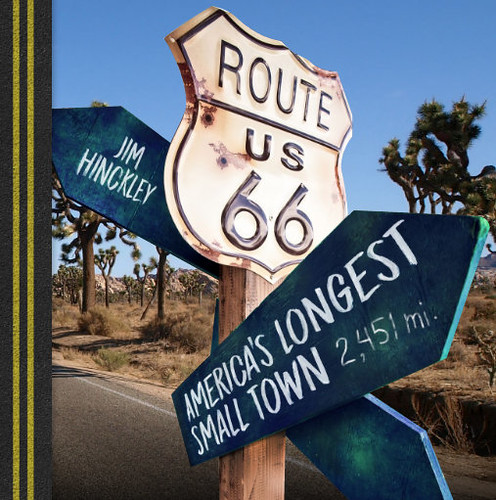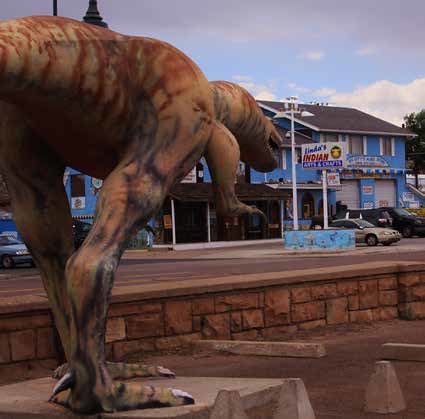In Route 66: America's Longest Small Town, author and Route 66 expert Jim Hinckley explores and discovers the people behind the iconic places and the current renaissance that has made the highway "America's longest attraction."
Route 66 in Arizona starts with great promise; colorful rock walls that stretch skyward serve as backdrops for a variety of trading posts that appear as though lifted from Kodachrome postcards from the 1950s. Hugging the state line are the remains of a movie set from 1950 turned trading post and a trading post linked to a murder at Two Guns in 1926.

Here's an excerpt from a chapter entitled Land of Opportunity:
Tragically, however, between the state line and Holbrook, Route 66 is little more than short stretches of gravel road, bits of broken asphalt, and the occasional picturesque bridge over a canyon or dry riverbed severed from the road it once connected. Still, amazingly, a few of these remnants have become destinations, icons that serve as the anchor for events that attract international participation in remote rural communities.
Chief among these is the ruins of the Painted Desert Trading Post marooned on a long-abandoned segment of Route 66 east of the Painted Desert Visitor Center in Petrified Forest National Park, the only national park bisected by Route 66. Built in the early 1940s on a knoll above the Dead River, the trading post was in such a remote location that it lacked phone or electrical service up until its closure in late 1956 or early 1957.
The scenic location that serves as a backdrop for the ruins of the trading post, the old highway stretching across the picturesque and colorful desert plain, and the haunting image of the historic Dead River Bridge below have come to symbolize the adventure of the Route 66 experience in the modern era. Dries Bessels, a founding member of the Dutch Route 66 Association, said, “On a trip to the Four Corners area I saw Russell Olsen’s book, Route 66: Lost and Found, with a picture of the Painted Desert Trading Post on the cover. At that time, we had heard about Route 66 but in a way that everybody in the world has. You know the song and think you know that the road is still out there, but you’re not very sure where exactly.” Bessels continued, “When I saw the picture of the Painted Desert Trading Post on the cover, I simply knew that I had to go there and see the building in real life.
Then, around 2007, a young friend of ours went from healthy with a small child to dead from aggressive liver cancer in less than three months. We went to the funeral, and the next morning I decided I was not going to wait anymore. No more, bucket list. That same day we, Marion and I, decided we would go and ride all of Route 66 on a motorcycle and we did so in 2009. “That year I went to the trading post on a motorcycle. I have been doing that every year since then on the annual Route 66 trip.”
Holbrook, the community closest to the national park, has yet to harness the resurgent interest in Route 66 as a catalyst for revitalization. That, however, began to change when in 2014 a group of volunteers working with the City of Holbrook, and the National Park Service, took a major step toward making the community a destination for enthusiasts, on at least one weekend each year.
The city’s Route 66 festival, aside from the traditional activities of music, car show, and presentations, included exclusive guided tours along Route 66 in the Painted Desert, a section of roadway closed to public access for decades, to the Painted Desert Trading Post with stops at other abandoned roadside businesses. In 2015, the second year of the festival, attendees traveled from as far away as Texas, Oklahoma, and Illinois to partake of the unique tour.

The Route 66 corridor in Holbrook is lined with colorful storefronts, vintage motels, long-shuttered businesses, and whimsical creations.
Two historic Route 66 sites of particular note are in Holbrook; both are indicative of how the highway continues to evolve. Wigwam Village, currently operating as the Wigwam Motel and still operated by the original family, opened in 1950. The owners have deftly balanced the preservation of the complex in as original a state as possible while providing the modern amenities expected by today’s travelers. Indicative of their success is the fact that reservations must be made weeks in advance during the peak season.
Almost directly across the street is the Globetrotter Lodge. In 1956, this property operated as the Whiting Motor Hotel and in the 1960s as the Sun ’N’ Sand Motel. The doors closed in 2001 and vandalism transformed the property into an eyesore. Mona and Peter Hoeller of Austria bought the derelict motel in 2009. Mona said, “Peter and I wanted walks in the former Soviet Union. “Our acquisition of the La Posada and relocating to Winslow was somewhat of an accident,” he said. “We learned that the historic hotel was an endangered property with its listing as such by the National Trust for Historic Preservation. We visited the property in 1994 and decided to assist local preservationists to save it.” At that time, there were plans for demolition. This was the beginning of a three-year struggle that included negotiation with the railroad, the resolution of legal, environmental, and financial obstacles, and the establishment of La Posada LLC with Daniel Lutzick as general manager. Renovation was a daunting task as the restaurant had closed in 1956 and the hotel in 1959, and the railroad had transformed the facility into an office complex.

The historic La Posada is a masterpiece of renovation that highlights the potential of a dedicated preservationist.
As it turned out, transformation of the derelict property into a world-renowned resort hotel was only the first step. Recently, a Tesla charging station was added to the property, as well as the largest privately owned solar power generating facility in the state of Arizona, which moved the hotel toward self-sufficiency and made it a showpiece of historical preservation. Plans call for the establishment of a vineyard and ornamental vegetable garden and the restoration of the former depot to house a Route 66 art museum.

The Globetrotter Lodge in Holbrook is a manifestation of how international interest in Route 66 is transforming communities.
As if the restoration of the hotel was not a large enough undertaking, Affedlt turned his attentions toward the revitalization and transformation of Winslow. He purchased and renovated the theater and served as mayor, while overseeing the updating of the city’s charter and creating a balanced budget. Surprisingly, the transformation of the Route 66 corridor in Winslow is still rather limited. While several blocks centering on the La Posada and Standing on the Corner Park now teem with visitors, and while there are plans for restoration of other properties, much of the area still appears as it did when the bypass of Route 66 decimated the historic business district.

The Standin’ on the Corner Park in Winslow exemplifies the way communities can link popular culture with the allure of Route 66 with dramatic results
In addition to writing numerous critically acclaimed and best-selling books, and hundreds of feature articles, about Route 66, Jim Hinckley has made presentations about traveling this highway internationally. His books are provided as part of a tour package by companies based in Norway and Australia. Hinckley also regularly assists with tour development, meets with tour groups and individuals traveling Route 66, serves as a Route 66 tourism development consultant for Ramada, and is a featured speaker at the Miles of Possibilities conference that is part of the 2015 Route 66 convention. Recently he accepted a position on the Route 66 Economic Development Committee that is a part of the Route 66: The Road Ahead Initiative facilitated by the National Park Service Route 66 Corridor Preservation Program.
Photos courtesy and copyright Jim Hinckley
